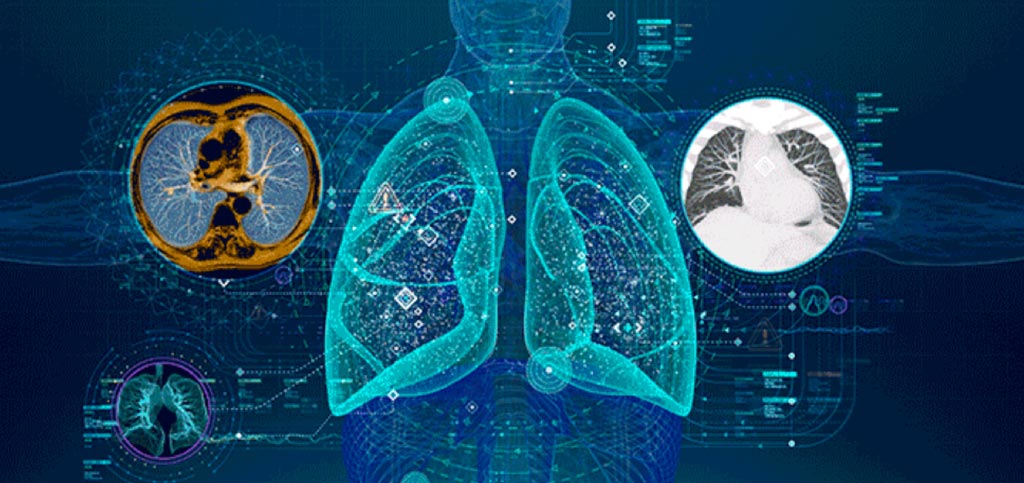AI Tool Combines Lung Screening CT with Clinical Data to Predict Lung Cancer without Radiologist Assistance
|
By HospiMedica International staff writers Posted on 28 Oct 2021 |

A new artificial intelligence (AI)-based model that combines lung screening computed tomography (CT) information with clinical data has been shown to better predict lung cancer without the need for manual reading.
The deep learning tool built by scientists at the Vanderbilt University (Nashville, TN, USA) integrates CT features such as nodule size and risk factors including age, pack-years smoked, cancer history, among others. The scientists developed and tested the co-learning model on exams of more than 23,000 patients and found that it outperformed risk models utilizing clinical or imaging data alone, including the popular Brock model.
The scientists developed the deep learning tool by applying a five-fold cross-validation approach to data of 23,505 patients from the National Lung Screening Trial. The team used screening data from close to 150 patients in an in-house program for external testing. The scientists found that the deep learning tool notched an area under the receiver operating characteristic curve score of 0.88, which was higher than published models dependent completely on imaging data (0.86) and clinical risk factors (0.69).
More importantly, the deep learning tool automatically pulls high-risk regions from CT exams without the need for any effort by the radiologist. However, gathering clinical data does involve manual effort from radiologists and physicians. The scientists believe that their co-learning approach could be particularly beneficial as more patients start to qualify for screening exams and the insights from the tool could find low-risk individuals to be actually high-risk.
“Risk estimation among lung screening participants will become even more important with the impending expansion of screening guidelines to include those patients who are considered lower risk only based on age and history of tobacco use,” stated Riqiang Gao, a PhD student in computer science at Vanderbilt University. “The role of [the] radiologist is still irreplaceable in terms of looking for and reporting clinically significant findings (emphysema, pulmonary fibrosis, atelectasis, etc.).”
Related Links:
Vanderbilt University
Latest Health IT News
- Printable Molecule-Selective Nanoparticles Enable Mass Production of Wearable Biosensors
- Smartwatches Could Detect Congestive Heart Failure
- Versatile Smart Patch Combines Health Monitoring and Drug Delivery
- Machine Learning Model Improves Mortality Risk Prediction for Cardiac Surgery Patients
- Strategic Collaboration to Develop and Integrate Generative AI into Healthcare
- AI-Enabled Operating Rooms Solution Helps Hospitals Maximize Utilization and Unlock Capacity
- AI Predicts Pancreatic Cancer Three Years before Diagnosis from Patients’ Medical Records
- First Fully Autonomous Generative AI Personalized Medical Authorizations System Reduces Care Delay
- Electronic Health Records May Be Key to Improving Patient Care, Study Finds
- AI Trained for Specific Vocal Biomarkers Could Accurately Predict Coronary Artery Disease
Channels
Critical Care
view channel
Ingestible Smart Capsule for Chemical Sensing in the Gut Moves Closer to Market
Intestinal gases are associated with several health conditions, including colon cancer, irritable bowel syndrome, and inflammatory bowel disease, and they have the potential to serve as crucial biomarkers... Read moreNovel Cannula Delivery System Enables Targeted Delivery of Imaging Agents and Drugs
Multiphoton microscopy has become an invaluable tool in neuroscience, allowing researchers to observe brain activity in real time with high-resolution imaging. A crucial aspect of many multiphoton microscopy... Read more
Novel Intrabronchial Method Delivers Cell Therapies in Critically Ill Patients on External Lung Support
Until now, administering cell therapies to patients on extracorporeal membrane oxygenation (ECMO)—a life-support system typically used for severe lung failure—has been nearly impossible.... Read moreSurgical Techniques
view channel
Intravascular Imaging for Guiding Stent Implantation Ensures Safer Stenting Procedures
Patients diagnosed with coronary artery disease, which is caused by plaque accumulation within the arteries leading to chest pain, shortness of breath, and potential heart attacks, frequently undergo percutaneous... Read more
World's First AI Surgical Guidance Platform Allows Surgeons to Measure Success in Real-Time
Surgeons have always faced challenges in measuring their progress toward surgical goals during procedures. Traditionally, obtaining measurements required stepping out of the sterile environment to perform... Read morePatient Care
view channel
Portable Biosensor Platform to Reduce Hospital-Acquired Infections
Approximately 4 million patients in the European Union acquire healthcare-associated infections (HAIs) or nosocomial infections each year, with around 37,000 deaths directly resulting from these infections,... Read moreFirst-Of-Its-Kind Portable Germicidal Light Technology Disinfects High-Touch Clinical Surfaces in Seconds
Reducing healthcare-acquired infections (HAIs) remains a pressing issue within global healthcare systems. In the United States alone, 1.7 million patients contract HAIs annually, leading to approximately... Read more
Surgical Capacity Optimization Solution Helps Hospitals Boost OR Utilization
An innovative solution has the capability to transform surgical capacity utilization by targeting the root cause of surgical block time inefficiencies. Fujitsu Limited’s (Tokyo, Japan) Surgical Capacity... Read more
Game-Changing Innovation in Surgical Instrument Sterilization Significantly Improves OR Throughput
A groundbreaking innovation enables hospitals to significantly improve instrument processing time and throughput in operating rooms (ORs) and sterile processing departments. Turbett Surgical, Inc.... Read moreHealth IT
view channel
Printable Molecule-Selective Nanoparticles Enable Mass Production of Wearable Biosensors
The future of medicine is likely to focus on the personalization of healthcare—understanding exactly what an individual requires and delivering the appropriate combination of nutrients, metabolites, and... Read more
Smartwatches Could Detect Congestive Heart Failure
Diagnosing congestive heart failure (CHF) typically requires expensive and time-consuming imaging techniques like echocardiography, also known as cardiac ultrasound. Previously, detecting CHF by analyzing... Read moreBusiness
view channel
Expanded Collaboration to Transform OR Technology Through AI and Automation
The expansion of an existing collaboration between three leading companies aims to develop artificial intelligence (AI)-driven solutions for smart operating rooms with sophisticated monitoring and automation.... Read more


















